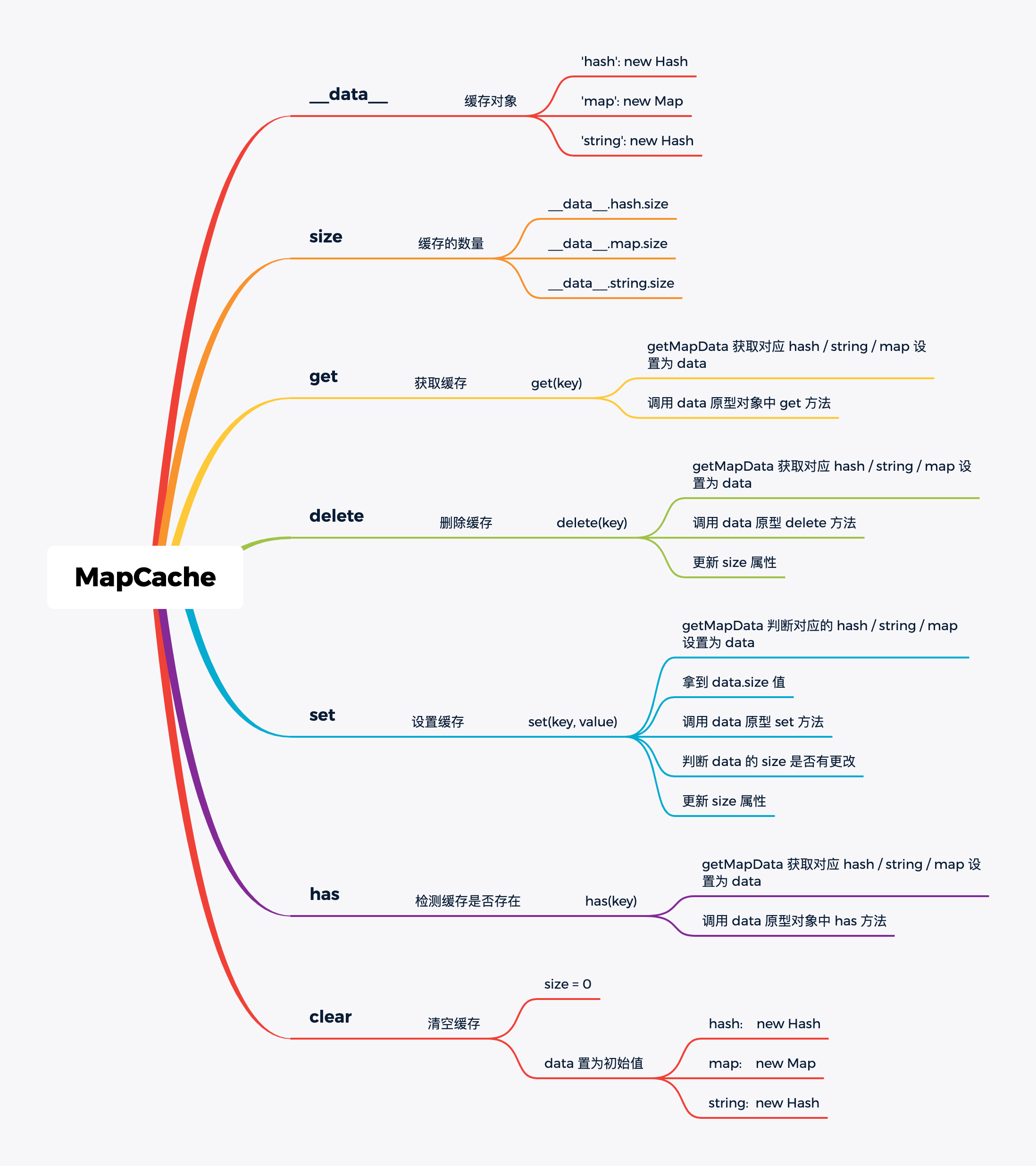# MapCache
# Description
创建一个映射缓存对象来存储键值对。
MapCache {
size: 3,
__data__: {
hash: Hash { __data__: [Object: null prototype] {}, size: 0 },
map: Map {},
string: Hash { __data__: [Object: null prototype] { A: 'A-value', B: 'B-value', C: 'C-value' }, size: 3 }
}
}
# Params
{Array} [entries] -- 要缓存的键值对
# Depend
import Hash from './Hash.js'
# Code
/**
* Gets the data for `map`.
*
* @private
* @param {Object} map The map to query.
* @param {string} key The reference key.
* @returns {*} Returns the map data.
*/
function getMapData({ __data__ }, key) {
const data = __data__
return isKeyable(key)
? data[typeof key === 'string' ? 'string' : 'hash']
: data.map
}
/**
* Checks if `value` is suitable for use as unique object key.
*
* @private
* @param {*} value The value to check.
* @returns {boolean} Returns `true` if `value` is suitable, else `false`.
*/
function isKeyable(value) {
const type = typeof value
return (type === 'string' || type === 'number' || type === 'symbol' || type === 'boolean')
? (value !== '__proto__')
: (value === null)
}
class MapCache {
/**
* Creates a map cache object to store key-value pairs.
*
* @private
* @constructor
* @param {Array} [entries] The key-value pairs to cache.
*/
constructor(entries) {
let index = -1
const length = entries == null ? 0 : entries.length
this.clear()
while (++index < length) {
const entry = entries[index]
this.set(entry[0], entry[1])
}
}
/**
* Removes all key-value entries from the map.
*
* @memberOf MapCache
*/
clear() {
this.size = 0
this.__data__ = {
'hash': new Hash,
'map': new Map,
'string': new Hash
}
}
/**
* Removes `key` and its value from the map.
*
* @memberOf MapCache
* @param {string} key The key of the value to remove.
* @returns {boolean} Returns `true` if the entry was removed, else `false`.
*/
delete(key) {
const result = getMapData(this, key)['delete'](key)
this.size -= result ? 1 : 0
return result
}
/**
* Gets the map value for `key`.
*
* @memberOf MapCache
* @param {string} key The key of the value to get.
* @returns {*} Returns the entry value.
*/
get(key) {
return getMapData(this, key).get(key)
}
/**
* Checks if a map value for `key` exists.
*
* @memberOf MapCache
* @param {string} key The key of the entry to check.
* @returns {boolean} Returns `true` if an entry for `key` exists, else `false`.
*/
has(key) {
return getMapData(this, key).has(key)
}
/**
* Sets the map `key` to `value`.
*
* @memberOf MapCache
* @param {string} key The key of the value to set.
* @param {*} value The value to set.
* @returns {Object} Returns the map cache instance.
*/
set(key, value) {
const data = getMapData(this, key)
const size = data.size
data.set(key, value)
this.size += data.size == size ? 0 : 1
return this
}
}
# Analyze

MapCache 作为一个缓存 键值对的类 ,其数据结构如图所示, 返回的数据结构为
MapCache {
size: 6,
__data__: {
hash: Hash { __data__: [Object: null prototype], size: 3 },
map: Map { [Number: 1] => 'number', [String: '1'] => 'string' },
string: Hash { __data__: [Object: null prototype], size: 1 }
}
}
提供了 get set delete clear has 5个方法
除 MapCache 自身的方法之外,它依赖于 isKeyable 和 getMapData 方法来处理 key 值的类型以及保存的形式
# isKeyable
isKeyable 通过传入 value 来判断 value 是否适合作为唯一 key 值
- 首先拿到
value的type类型 - 如果
value的类型 存在于string、number、symbol、boolean中时,判断并返回value !== '__proto__' - 如果 value 的类型不属于上述时,判断并返回
value === null
# getMapData
根据 key 值来判断 返回 __data__ 的某个子级实例
- 首先通过结构赋值拿到
__data__ - 根据
isKeyable判断key是否适合作为唯一的key值 - 如果适合,在判断
key是否为string,如果为string返回__data__.string, 否则返回__data__.hash - 如果不适合, 返回
__data__.map
# constructor
- 首先传入一个 键值对数组 ,拿到
length - 调用
clear进行值的初始化 - 因为
index定义为-1,所以使用++index < length,while循环进行数据的缓存 - 拿到对应下标的值,通过
set方法进行数据的存储
# get
- 通过
getMapData拿到key值对应的实例 - 调用实例的
get方法获取值
# delete
从列表缓存中移除 key 及其值,成功返回 true 并更新 size ,失败返回 false
- 通过
getMapData拿到key值对应的实例 - 调用 实例 的
delete方法,并拿到返回值 - 判断返回值 真假,对应更新
MapCache.size属性 - 返回 成功或失败
# set
通过 key value 设置键值对,并且维护更新 size 属性
- 通过
getMapData拿到key值对应的实例 - 缓存实例的
size属性 (数据长度) - 调用 实例
set方法进行数据缓存 - 根据调用
set之后的size和 缓存的size进行比较,根据比较结果更新MapCache.size - 返回
this
# has
判断 __data__ 中是否存在对应的 key ,存在返回 true ,不存在返回 false
- 通过
getMapData拿到key值对应的实例 - 调用实例的
has方法判断key值是否存在
# clear
- 更新 size 属性为 0
- 设置
__data__为初始值
# Remark
一个 Map 的键可以是任意值,包括函数、对象或任意基本类型。
尽管,Map 相对于 Object 有很多优点,依然存在某些使用 Object 会更好的场景,毕竟 Object 是 JavaScript 中最基础的概念。
- 如果你知道所有的 key,它们都为字符串或整数(或是 Symbol 类型),你需要一个简单的结构去存储这些数据,Object 是一个非常好的选择。构建一个 Object 并通过知道的特定 key 获取元素的性能要优于 Map(字面量 vs 构造函数,直接获取 vs get() 方法)。
- 如果需要在对象中保持自己独有的逻辑和属性,只能使用 Object。
# Example
const arr = [
[Symbol(1), 'symbol'],
[new Number(1), 'number'],
[new String(1), 'string'],
[true, 'boolean'],
[1, '1'],
['A', 'A'],
[NaN, NaN],
]
/**
* MapCache {
* size: 7,
* __data__: {
* hash: Hash { __data__: [Object: null prototype], size: 4 },
* map: Map { [Number: 1] => 'number', [String: '1'] => 'string' },
* string: Hash { __data__: [Object: null prototype], size: 1 }
* }
* }
*
*/
const temp = new MapCache(arr)
temp.get(1) // 1
temp.get('A') // A
temp.get(true) // boolean
/**
* MapCache {
* size: 8,
* __data__: {
* hash: Hash { __data__: [Object: null prototype], size: 4 },
* map: Map {
* [Number: 1] => 'number',
* [String: '1'] => 'string',
* [MapCache] => 'MapCache'
* },
* string: Hash { __data__: [Object: null prototype], size: 1 }
* }
* }
*
*/
temp.set(new MapCache(), 'MapCache')
temp.delete('A') // true
temp.has('A') // false
temp.has(NaN) // true
/**
* MapCache {
* size: 0,
* __data__: {
* hash: Hash { __data__: [Object: null prototype] {}, size: 0 },
* map: Map {},
* string: Hash { __data__: [Object: null prototype] {}, size: 0 }
* }
* }
*
*/
temp.clear()
← ListCache mapToArray →